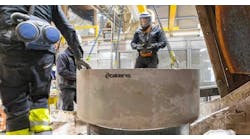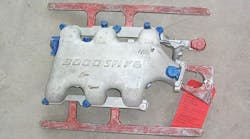Die coating in gravity diecasting is one of the operational parameters of the casting process that is often overlooked or misunderstood. Die coatings are necessary for three basic reasons.
Coatings provide a protective barrier between the die and the casting to prevent die erosion and wear.
Coatings provide some degree of control over the solidification rate and direction.
Coatings provide a barrier between the die and casting so that the casting will release from the die.
With proper use, a die coating can be used to control the thermal gradients such that directional solidification can be achieved. This allows a pathway for feed metal to flow into the solidifying structure and compensate for normal metal shrinkage during solidification. This is particularly important in castings with thin sections that expand to thicker sections: The thin areas must remain open to ensure that shrinkage will not occur in the adjacent thick section.
Starting a New Die
In some casting designs there may be two or more characteristics working against each another. For example, a design might have a thin-walled section in need of additional insulation to prolong solidification, yet it is also in an area that is difficult to release form the die. In this case a compromise must be reached.
By their nature release coatings are not isolative, and isolative coatings will not aid in the release of tight or difficult geometries. In such cases a choice must be made as to which of the operational characteristics is most important. One choice may be to use a combination coating, which will allow for some insulation and some release. Another option is to use an insulating coating as a base coat and a release topcoat.
Insulating coatings vary greatly in insulating qualities as well as the surface finishes they will impart to the casting. The insulating qualities of a coating are a function of the type of refractory filler that is used and their thermal conductivity and heat capacity.
Also contributing to a coating’s isolative capabilities, as well as surface finish, is the amount of binder and the dilution rate. Typically, binders are a sodium silicate. Typical refractory materials found in die coatings include: vermiculite, bentonite, talc, titanium dioxide, alumina, olivine, and graphite
Both release and chill coatings contain materials that act as heat conductors to allow for more rapid solidification while protecting the die against wear. Release coatings typically contain graphite as the lubricant, which is non-wetting by aluminum.
Die Coating Application
As in any coating application, surface preparation is critical. A new die should arrive from the pattern shop clean of all oils and cutting fluids. The parting line should be clean and flat, with return and ejector pins flush. The casting cavity must be sand blasted with 80 grit coal slag to ensure that the cavity surfaces have a “tooth” or texture that will allow the coating to stick to the die. Sand may be used in place of the coal slag if necessary.
Dies that have been in service must have all the old coating completely removed. The types of cleaning media used vary, and may include blasting with coal slag, sand, metal shot, grit, glass beads and dry ice (CO2). The choice depends on availability as well as how difficult the coating is to remove. In most cases, dry ice blasting is recommended for routine cleaning with periodic coal slag blasting to restore the die surface finish for die coating. Over-blasting, especially with sand, shot, or grit, erodes die details and shortens die life.
Die coatings should be sprayed on to the die surface with an airless spray gun. Spraying equipment may be any one of many different styles and types of spray guns. Using a paint gun is not recommended as the heavy materials in the die coating easily clog the small ports. A siphon type gun, which has one straight fluid tube with replaceable fluid tips, works well.
Some siphon guns are available with interchangeable pots. With extra pots, two or three different types of coating may be kept on hand, mixed and ready. As the need arises for a particular coating, it may be snapped on the spray head and used immediately.
In areas where a high degree of insulation is required, such as gates, runners, risers, and pouring cups, brushing the coating on provides more insulating capability. In addition to the insulating properties of the coating itself, brushing will trap air bubbles, which enhance insulation. Additionally, the rough surface caused by brushing can aid molten metal flow through the gating system by continuously disrupting the oxide skin as the metal flows.
Proper safety gear should be used when coating a die, including gloves, protective sleeves, boots, and eye and ear protection. Thoroughly mix the coating in its original container before diluting or using only a portion of the can weight. This will alleviate any settling problems that occur during transit and storage. When diluting, soft warm water works best, but cold water is acceptable. In either case, adequate mixing with any equipment such as a lighting mixer or a bent rod in a hand drill is required. Excessive shear should be avoided.
Die Heating, Coating
The die should be heated to 600o F (315o C), and care must be taken to heat the die uniformly. A magnetic thermometer, optical pyrometer, or a temple stick should be used to check the temperature periodically. The die should dry-ice blasted to remove any soot that developed. Spray the die lightly with water. This will create a porous oxide film on the die, which will provide a good surface for the die coating to bond.
The water spray also cools the die to the desired coating application temperature, 350o-400o F (75o-200o C). If the die is too hot, the rapidly expanding water vapor front moving away from the die will cause a phenomenon known as “kick back,” and very little coating will adhere to the die. Even the coating that does adhere will not be properly bonded. If the die is too cold the coating might run, resulting in an uneven surface.
Extend the ejector pins. While the die is still above 300o F (150o C), spray the extended ends of the ejector pins with HALLCoat986 or comparable graphite die coating spray. Retract the ejector pins back into the die and dry-ice blast the die face to remove all graphite die coating from the die face, as the primer coat will not adhere to the graphite.
Now the die is ready to prime. The purpose of the primer coat is to create the best possible adherence of the coating to the die. This occurs because very diluted sodium-silicate solutions allow bonds to form that are more parallel to the die face. This structure forms a stronger bond, which is more resistant to wear. In contrast, high sodium-silicate solutions create bonds that are perpendicular to the die face and can be sheared away. Care must be taken not to over dilute the primer coating as sufficient sodium silicate must be present generate the bond.
Once the primer is applied, the main coating can be applied at higher concentrations. Thoroughly stir the HALLCoat 520RH die coating. Transfer the mixed coating into the spray gun can and dilute 6:1 with clean water. Spray the entire cavity, including gates, risers, and pouring cup, with a light primer coat. Avoid spaying the parting line.
The next step is die coating. Place a small amount of HALLCoat 520 RH in the spray pot. Dilute to a ratio of approximately 2:1. After diluting, place a small amount of coating in a Baume beaker and place a Baume gage in the beaker. The Baume reading should be between 22-26.
Spray the entire cavity, gates, and riser, avoiding the parting face. Do not try to cover the cavity with one heavy coating. A gradual build-up of the coating is preferred over one heavy coat. The number of coats and the exact coating thickness will vary with the casting design and may vary within the die itself. Check the coating thickness with a Posi-Pen. A working profile should be developed for areas that require a heavier or thinner application of coating to aid solidification. A coating thickness of 10-20 mils is typical. After the coating has cured, excess coating should be removed from the parting line and core prints with a wire brush or brass scraper.
The final step is to paint the gating risers, and pouring cup. A softer highly isolative coating is required, such as HALLCoat600, or equivalent. The coating should be brushed on the desired surfaces with a soft paint bush. The process should be repeated until the coating is the thickness of a dime.
Isolated heavy sections in the die will require “trimming”. The next step is to remove or thin the coating in the areas that require rapid solidification. This can be done with a brass scraper, steel wool, or a wire brush mounted in a die grinder. After trimming, the exposed steel should be sprayed with HALLCoat986 to prevent aluminum from welding to the steel die. Now, the die should be reheated to pouring temperature approximately 800o F.
Once the coating procedure for a particular casting is finalized the method must be recorded for future reference. One method is to mark a sample casting with paint. In the attached photo, the unpainted areas have a standard coating, the blue painted areas are trimmed and coated with HALLCoat986 graphite coating, and the red painted runners and risers are coated with HALLCoat600 isolative coating.
Most commercial die coating materials are bonded by sodium silicate with various filler materials for their isolative, lubricating, or cosmetic qualities. Die coating is supplied in 5-gal. cans or 55-gal. drums. The coatings should be stored in their original covered containers with the lids firmly in place when not in use. Die coating should be stored in a dry place away from excessive heat or cold, or drastic temperature change. Ideal storage temperatures range from 50o -75o F (10o-25o C). Under no circumstances should the coating material be allowed to freeze, as subsequent thawing may not restore the coating to its original condition. Refer to the manufacturer’s instructions for additional storage information.
Touching up a die while in use follows much the process as preparing a new die, but some extra rules must be used. Make sure any sheared or welded-on aluminum is removed before adding the touch-up coat. If the coating area is spalled, cracked, or blistered, be sure to remove it with sandpaper, steel wool, brass brush or brass scraper.
John Hall is the president of C.M.H. Manufacturing. For more detail, visit www.cmhmfg.com









